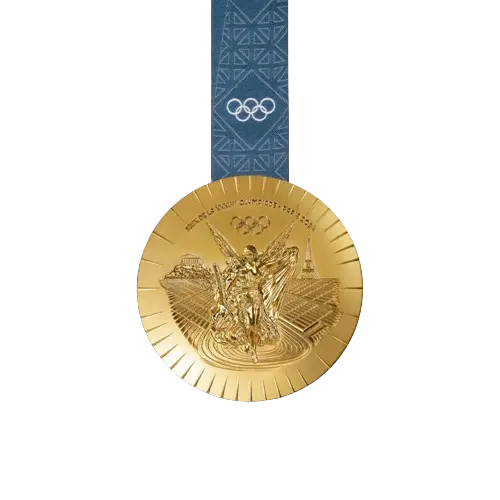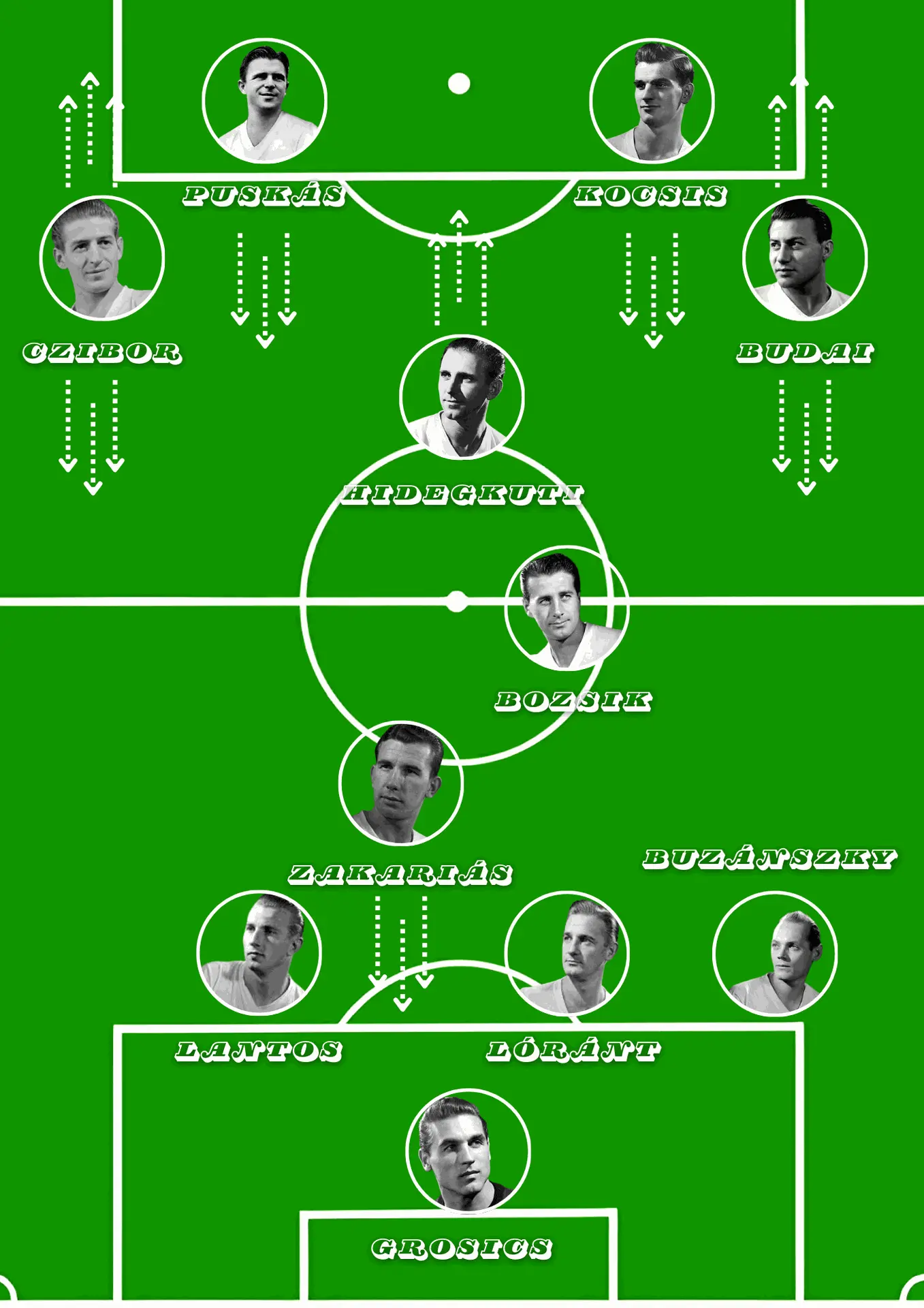The Best International Team of the 50s
The Hungarian Golden Eleven 1949-56
The name "Hungarian Golden Eleven" refers to one of the best teams of all time, as much for its individualities as for its modern game and its efficiency. This Hungarian national team which began in 1949 was simply irresistible and almost unbeatable.

A more than promising start
The beginnings of this team were therefore in 1949, under the orders of their famous coach: Gusztáv Sebes, a former Hungarian player from the 20s/30s who notably had a stint in the French championship. He also had the honor of wearing the Hungarian jersey in 1936.
During this first year at the head of the national team, Gusztáv Sebes' record is dithyrambic. Indeed, for its first match, his team faced Austria, the land of football which was crushed 6 goals to 1 thanks to goals from Puskás (3), Kocsis, Deák (2). In the following matches, the attack line was confirmed with first of all Ferenc Deák, the legend of the country who piled up the goals. Prestigious draw against Italy (1-1), also draw (2-2) against Sweden. Exceptional victory 8 goals to 2 against Poland, Ferenc Deák scores 4 goals! Ferenc Puskás scores 2. We are witnessing the emergence of an elite player. Ferenc Deák continued to score in the next three victories against Austria again (4 goals to 3), Bulgaria (5-0) and Sweden (5-0).
This year, 1949, was therefore the year of emergence, Hungary, which already had a rich footballing history, found color in a country under the control of the totalitarian regime. The National Cup is suspended in order to give more recovery time to the players of the selection. The objective is simple, the regime in place wants to make the country's football shine to erase the situation of poverty within the country.
A tactic that reflects a society
Under communist rule, Hungarian football was also impacted by this philosophy. This is what we will call socialist football. It's a real tactical revolution, at the time the WM is the favored composition and is almost omnipresent. This tactic allows you to perfectly match another WM and therefore to have an individual marking. At that time, dribbling and therefore individual qualities were the only ways to make a difference. But this new “socialist” approach will turn everything upside down.
This new tactic can be considered a revolution and the entry into the modern tactical age of football. In this vision, player movements are essential, the game must be fast and fluid. The pattern is a sort of 4-2-4 with József Zakariás who plays both central defender in the defensive phase and defensive midfielder in the offensive phase in order to provide more solutions to József Bozsik, the providential man in the midfield Hungarian who is joined on numerous occasions by Nándor Hidegkuti, the offensive launching pad, and incidentally the first false 9 in history.
A modern tactic
Tactically, we therefore find 4 defenders, Gyula Lóránt, Jenő Buzánszky, Mihály Lantos and József Zakariás who place themselves in front of their legendary goalkeeper: Gyula Grosics. The midfield consists of József Zakariás again, in this hybrid role. József Bozsik as relay runner and playmaker and Nándor Hidegkuti, number 9 of the team who broke the codes of the time.
Nándor Hidegkuti, the first modern false 9 in history, was not up to the standards of the number 9s of the time who wanted to be physical and almost brutes on the field. No, he was this genius, the brains of the team. This player who constantly broke away in midfield, who helped defend and who had tactical freedom linked to his great intelligence of the game.
Technically gifted, quite fast and above all an excellent passer, he was the real launching pad for the Hungarian assaults. Able to play with one touch, make one-twos, or fire missiles into the top corner, he was this complete player, ideal for the team.
The offensive line is also full of talent, we find two of the best center forwards in history: Ferenc Puskás who will wear number 10 and Sándor Kocsis with number 8. The two players are very complementary, the first is an ultra player -complete, who is one of the very best players in history. Very good at finishing, Puskás is also a formidable dribbler, very efficient and a player with exceptional vision of the game. Alongside him, Kocsis is a traditional striker, one if not the best heading player in the history of football. They both have a ratio of almost 1 goal per match in the selection.
On the sides we find wingers who are rather classic in terms of their characteristics but also very intelligent, the two swap a lot, and it is common to find Czibor on the right and Budai on the left during offensive phases. They have this quality of speed and defensive withdrawal which is so useful to Hungarian tactics. It is a precursor football to the future Dutch total football where everyone defends and makes efforts for their teammates.
Tactically, one thing is particularly interesting, the absence of individual marking, in fact, for one of the first times in history, the marking is zone marking. That is to say that we no longer follow a particular player but we occupy a defined space and we do the defensive work in this area.
The Olympic Games and the legend of the invincibles
In this year 1950, it is another center forward who will reveal himself and show his effectiveness in the group: Gyula Szilágyi. Even if this player will only obtain 12 caps for the A team with Hungary during his entire career, this year 1950 remains in the memories. First of all, the first match, where he scored a goal and participated in the victory against Czechoslovakia 5 goals to 0. In the following match it was Sebes' first defeat on the Hungarian bench, 3 goals to 5, a crazy match in Vienna against Austria, Szilágyi scores again. Next match, Poland is the opponent, victory 5 goals to 2, Szilágyi scores a hat-trick. The following match was historic, a 12-0 victory against poor Albania. It is Budai who benefits with 4 goals scored, just like Puskás. Gyula Szilágyi will be there for the last two matches of this year 1950, 2 complicated matches, the first against Austria (victory 4 goals to 3), and the second against Bulgaria (1-1 draw), Szilágyi scores a goal in each of the matches, and will unfortunately never play again in the Hungarian jersey, despite very good individual results.
This Hungarian team no longer loses, they become invincible and the 11th freezes with the previously mentioned players. The only changes are the recurrence of introductions of new center forwards within the squad, introductions that are often decisive but of little significance over time.
1952, Hungary has not lost since May 14, 1950, arriving as one of the favorites of the Olympic Games, at the time the operation was different, the tournament had a real value, providing more in a context of the Cold War where both the Eastern bloc and the Western bloc wanted to shine on the international stage.
Their first match is Romania, quiet victory 2 goals to 1 against their opponent. Czibor and Kocsis are the scorers of the match. The next match promises to be more complicated, it is Italy, but the latter is defeated 3-0 by the Magyars. 3rd match, Turkey, it's just a formality, victory 7 goals to 1, Kocsis and Puskás score a double. Péter Palotás is also one of the players of the tournament, he scores 4 goals in total. During the semi-final, Sweden was crushed 6 goals to 0, nothing could stop Hungary from reaching the final and who could beat them? Not Yugoslavia in any case, which lost 2 goals to 0 in the final because of goals from Puskás and Czibor.
The match of the century
Hungary are now the best team in the world and by far they seem invincible, except for... England, who arrogantly, organizes a prestige match at Wembley on November 25, 1953. English journalists make fun of the Hungarian players which they criticize as amateurs. The English players make fun of the Hungarian players when they enter the field because of their outfits, light shoes, jerseys adapted to the size and build of the players... the Hungarian team is truly the first modern team.
Ah English arrogance... it only took 45 seconds for Hidegkuti to score with a missile into the top corner. The English are overwhelmed, the individual marking that the English do is destabilized by the incessant movements of the Hungarian players, doubling, triangle play, lob in depth, the English do not succeed, the Hungarian players put on a recital, a beautiful match. The score is there, Hungary wins 6 goals to 3 in what many call the match of the century.
The World Cup and the end of the Golden Eleven
There is no longer any doubt, Hungary is the best team in the world and many journalists of the time agree that they are the best team of all time. They have no equivalents.They only need one thing to definitively enter the legend and establish themselves as the best team of all time: the World Cup and that's good, it took place in 1954.
This World Cup which is taking place in Switzerland must therefore be the one of consecration, of the world title. The group stages went wonderfully well despite the injury of their leader during the second match: Puskás. The latter scored a double against South Korea in the 9-0 victory then a goal against West Germany in a crazy match 8 goals to 3 to the advantage of the Magyars.
In the next match, against Brazil, Hungary won the match 4 goals to 2, and the star who we have not yet talked about at the moment is none other than Sándor Kocsis, hat-trick in the first match, quadruple in the next, double against Brazil. Once again, the man nicknamed Golden Helmet thanks to his heading shines and establishes himself as the ultimate offensive weapon of this Hungary during this tournament. But there are 2 games left before being crowned. They find Uruguay, which establishes itself as a formidable opponent which pushes the Magyars into overtime, final score 4 goals to 2, another double for Kocsis.
It's time for the grand final, on July 4, 1954, Hungary finding Puskás scoring twice. At half-time the score is 2-0, everyone sees Hungary already world champion. But upon returning from the locker room, Germany seemed transformed and on a disastrous pitch, they managed to reverse the situation. The Hungarians are overwhelmed and can no longer score. Germany scores 3 goals, one of the greatest comebacks in history. Hungary is defeated... for the first time in 3 years, during the most important match in its history, a sad disappointment for a team which had everything to win.
Subsequently, questions will emerge about the sudden rise of the Germans, even going as far as research and accusations of doping on the part of the German players, but the result is there, Hungary lost.
After the World Cup, the Hungarian golden eleven continues to make people dream, but we know, their luck has passed. What we consider to be the Hungarian Golden Eleven ended in 1956, after a victory against the USSR team 1 goal to 0 and a goal from the legendary winger Czibor. In total, between 1950 and 1956, the golden eleven accumulated 42 victories, 7 draws and one defeat. The Hungarian Golden Eleven still managed to win 2 trophies, the Olympic Games and the 1948-53 International Cup.
Trophies :

World Cup Finalist x1
- 1954

Olympic Games x1
- 1952
International Cup x1
- 1948 - 1953
